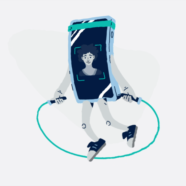- #all
- #banking
- #biometrics
- #business
- #culture
- #digital identity
- #elections
- #ethics
- #facial recognition
- #fingerprint recognition
- #government
- #iris recognition
- #NIST
- #onboarding
- #online elections
- #technology
- #trust
- #UX
- #voice recognition

VR travel, space data or energy: how far can the sharing economy go?
Luxurious cars, electric bikes, or extravagant vacation homes – thanks to the sharing economy, you can have all these things without “having” any of them. But how far can this trend stretch? Let’s explore how the sharing economy will shape industries in the coming years.

How biometric identity verification protects passengers using
ride-hailing apps
To get home one night, you order a taxi through a ride-hailing app. You don’t check who your driver is because you don’t have to. With driver face verification and liveness check algorithms, you know that the ride-hailing app continuously verifies thousands of drivers, making all the rides you take safe.

From sci-fi to reality:
How biometrics has travelled through movie screens and into our daily lives
How well did sci-fi movies of the past predict the biometric technologies that are now a reality, and which sci-fi concepts have remained fiction?

“Thanks to powerful servers, training a face recognition algorithm now takes just ten days instead of a year,” says R&D lead Jakub Sochor
For decades, fingerprint recognition has been the holy grail of secure biometric authentication. Yet, with the rapid progression and widespread acceptance of facial recognition, is there a new frontrunner?

“When companies seek biometric services, it shows responsibility and care,” says remote identity verification expert
The pandemic kickstarted the use of biometrics. Solutions like remote identity verification made it easier for major companies to operate, and since then, this technology has become widespread, especially in areas like the sharing economy.

Carpooling in wartime
and spare air mattresses:
a visual history
of the sharing economy
From gathering food around a tribal fire to downloading popular MP3 songs in the late 1990s, sharing is something humans have always done. Join us on a visual journey through the decentralised economy and discover how technology has revolutionised the way we share – disrupting both industries and society in the last few decades.

How to apply colour psychology in the redesign of biometric applications
Biometric applications should not only be technologically advanced, but also as easy to understand and navigate as possible. Delve into how Innovatrics applied colour psychology principles in the ABIS redesign, creating a consistent visual language and simplifying tasks for thousands of users.

Designing a technology that detects falls in nursing homes and the homes of the elderly
Over 25% of individuals aged 65+ fall each year, but fewer than half report it to their doctor, increasing the risk of recurring falls. These falls often result in injuries, hospitalisations, and emotional distress. Attentify, part of Biometric Ventures, tackles this issue by aiding caregivers in fall detection at home or in professional settings.

Is facial recognition helping or hurting law enforcement?
While the majority of people in the United States approve of the police using facial recognition technology, experts warn that some may be relying on it too heavily, and that the level of human involvement still required cannot be underestimated.

Former NYPD inspector Joseph Courtesis:
“We create less bias when we use facial recognition algorithms in our work.”
Concerns about biometric recognition algorithms often come down to the issue of tackling racial or gender bias.








